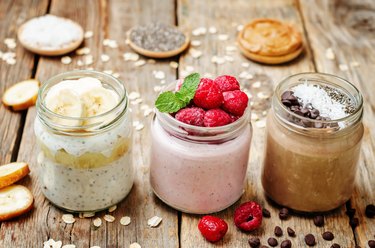
What's your breakfast of choice? Fried eggs? A smoothie? Cold cereal? There's really no wrong answer to that question, but oats are undeniably among of the most popular (and delicious) breakfast options. You'd be hard-pressed to find a more nutrient-rich foundation for your breakfast than oats. Whether you take yours steel-cut, stone-ground, old-fashioned, quick-cooking rolled or even as granola or scones made with oatmeal flour, you're still digging into a whole grain with all the nutrients of bran and germ included. Oats are higher in protein and heart-healthy unsaturated fats than most other grains, and even their carbohydrates are heavily skewed toward fiber. This includes unusually high levels of gut-friendly soluble fiber—beta-glucans—which act as a probiotic and help moderate blood sugar and cholesterol.
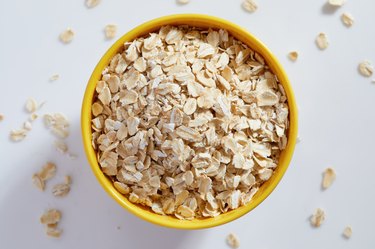
Video of the Day
Tip
Oats are naturally gluten-free, they but aren’t always processed in gluten-free facilities. If you have celiac disease or a significant gluten sensitivity, look for oats that are certified gluten-free.
Oats also have the happy characteristic of keeping you full for a long time. Protein, lipids (fat and oils) and fiber are all known to help with feelings of satiety, and oats are relatively high in all three (as grains go), so this isn't entirely surprising. And, of course, oatmeal itself is only the base. You can round out its flavor and make it even more filling with add-ins galore.
Video of the Day
These add-ins are limited only by your imagination and by how you choose to prepare your oats. So rather than spout off a laundry list of possible additions, let's take a look at some popular preparation methods and add-ins that are appropriate for each one.
Part 1: Overnight Oats

What are Overnight Oats?
Porridge might be the classic form of oatmeal, but since the early days of this century (and not incidentally, the early days of social media), overnight oats have been a popular alternative. The idea is simple: Instead of cooking oats to soften them and make them appealing, you mix them with an appropriate liquid—typically milk, yogurt or the dairy-free equivalent of your choice—and leave them in the fridge overnight to absorb liquid and soften. In the morning, all you need to do is reach into the fridge, pull out a portion and put your spoon to work. That's a level of preparation that even the most cooking-challenged can handle, right?
How to make Overnight Oats:
The core recipe is very straightforward. It consists of equal parts oats and milk—or equivalent by volume—plus whichever add-ins you choose. Depending on your appetite, a reasonable portion for oats and liquid is something in the range of 1/3 to 1/2 cup each. Measure into a suitable cup, bowl or other container (Mason jars are an especially popular option), then stir together (or layer them, if you like a more textural contrast) and pop your portions into the fridge. You can eat them in as little as 2 to 4 hours, but they're best when they get at least 8.
Tip
If you’re into meal prep and like to make multiple days’ food at a time, overnight oats will last 3 to 5 days in your fridge, depending on add-ins (which we’ll come back to in a moment). The oats will continue to soften with each passing day, so it’s usually desired texture that decides how many days in advance you prep.
Overnight Oats Tips & Tricks
1. Rolled Oats or Quick Oats: You can use old-fashioned rolled oats or small quick oats. Quick oats absorb moisture quickly (hence their name), so they'll provide a softer, almost mushy texture. Some prefer this, while others find it reminiscent of baby food!
2. Old-fashioned oats: These oats hang onto their texture longer, which makes them a better option if you're preparing more than a day's worth of oats at one time. Steel-cut oats, despite their excellence in porridge, aren't a great pick for overnight oats. They take too long to absorb moisture, remaining hard and chalky after spending a night in the fridge.
3. Thicker oats: If you prefer thicker oats, slightly reduce the amount of liquid. If you prefer them thinner, increase liquid. Bear in mind that oats don't expand as much after soaking as they do when you cook them. A half-cup of oats is just as filling either way, though, so you'll still feel just as full.
4. Liquid add-ins: Milk is a great starting point, but plain or flavored yogurt is a good choice on its own or as a replacement for part of the milk. (Greek yogurt, because it's extra thick, especially benefits from being cut half-and-half with milk.) If dairy products aren't your thing, then your alt-milk of choice—almond milk, soy milk, rice milk or even oat milk—will work fine. So will coconut milk, but be sure to buy the "drinking" kind in a carton rather than the "cooking" kind in a can; the cooking version contains loads of saturated fat. Even coconut water or fruit juice will work if you're feeling inspired to experiment.
5. Chia seeds or ground flaxseed: These help thicken overnight oats, giving them more of a porridge-y or pudding-y texture that many people appreciate. They also add extra nutrients and fiber, making your breakfast even healthier and keeping you full longer.
6. Fruit and berries: Berries and other fruits are ideal partners for the mildly sweet, unassertive flavor of oats. You can use dried, frozen or fresh fruit—whatever you've got and whatever you like. Dried fruit like raisins, apples or apricots, dates and berries can be added when you mix up overnight oats and won't affect their lifespan in the fridge. You might need to increase your liquids slightly because fruit will rehydrate and take moisture away from oats. Fresh or frozen fruits are better added each morning because they'll break down relatively quickly. Use your judgement: Fresh blueberries would last for a couple of days in your Mason jar, but strawberries won't.
7. Sweeteners: If you have a sweet tooth, you might prefer a smidge of actual sweetener over fruit. Maple syrup, honey and brown sugar are common options, as are the usual artificial sweeteners. You can also opt for chocolate chips, butterscotch chips, peanut butter chips or tiny marshmallows.
Tip
Want to create the perception of sweetness without adding a sweetener? A little splash of vanilla extract in your oats will do just that!
8. Protein options: If your morning starts with a trip to the gym, you might want to crank up your breakfast's protein content as well. Using yogurt as part of your liquid is one option, but there are lots of others. Adding pecans, almonds, walnuts or pumpkin seeds to your oats will increase their protein level. So will peanut butter, almond butter or other nut butter, either swirled in or added as a layer. Of course, there's always the option of simply adding protein powder to your mix (which is a pretty palatable way to increase your intake).
Part 2: Cooked Oatmeal
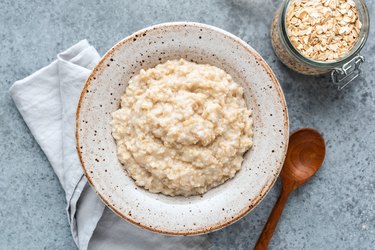
How does Oatmeal differ from Overnight Oats?
Cooked oatmeal (or porridge) requires—yes!—cooking to get the desired texture and can also be made instantly. The base recipe for cooked oatmeal is even simpler than the base recipe for overnight oats: It's just water and your choice of oatmeal.
How to cook Oatmeal:
Rolled Oats: Use 1 part water to 1 part oats (increasing or decreasing slightly to find your preferred consistency).
Steel-cut oats: It's typically 3 or 4 parts water to 1 part oats, depending on how finely they're ground. Quick oats will cook in a minute or so, old-fashioned rolled oats in five minutes, and steel-cut in 15 to 25 depending on their coarseness and the final texture you prefer. (Some folks like 'em softer, while others prefer a bit of "chew.") As easy recipes go, that's about as good as it gets. Zero prep time and a very manageable total time investment.
Overnight oatmeal: There are a few ways you can still have overnight oatmeal ready to go when you wake up, even if you prefer your oats cooked. Use your slow cooker, an electric pressure cooker with a slow-cooker setting or even some of the better rice cookers, any of which can keep cooked oats warm until morning. Alternatively, cook them normally (on your stovetop) the day before and pack them into a suitable container for storage in the fridge. The next morning, just pop a serving into the microwave for a minute or two. This is an especially good option in the case of steel-cut oats, which are relatively long-cooking.
Tip
If you opt to make your oats ahead of time in an appliance as part of your weekly meal plan, “test-drive” it once while you’re awake to actively monitor cooking. Oats tend to bubble up strongly while they cook (because of those same healthy beta-glucans) and can sometimes bubble over, clog vents or otherwise make a mess. You probably don’t want that to happen while unattended, so a trial run comes in handy. You can always make a smaller batch, if necessary, to reduce risk.
Cooked Oatmeal Tips & Tricks
1. Sweet-and-salty: A pinch of salt is optional but helps bring out the natural sweetness of oats.
2. Creamy texture: Replace part of the water with milk. (If you're using a cup of steel-cut oats and 4 cups water, for example, replace 1 cup water with 1 cup milk.) You'll just need to take care to prevent milk from scorching. If dairy milk isn't your thing, unsweetened almond milk, cashew milk or any other alt-milk will work just fine.
3. Cozy add-ins: Warm spices such as cinnamon, nutmeg and cloves make welcome additions to your morning bowl. If you're adventurous, less obvious options like cardamom and saffron can also be intriguing.
4. Fresh or dried fruit: Many popular toppings used in easy overnight oats work with cooked oatmeal, as well. The same basic rule applies: Add dried fruit during cooking, but add fresh fruit (especially delicate raspberries, strawberries, etc.) at serving time only. An exception might be firm fruit such as apples, which will stand up to the cooking process with just a bit of softening.
5. Sweeteners: For many of us, a sprinkling of brown sugar is the most traditional sweetener for porridge, but honey, maple or agave syrup and even applesauce or fruit preserves will do the job nicely. The latter could count as fruit or sweetener—it works either way!
6. Protein options: A splash of milk in cooked porridge is a pretty standard option, adding both calcium and protein, but you can always take things further. Stirring a spoonful of peanut butter or other nut butter into porridge makes it remarkably rich and creamy. Alternatively, you can simply add nuts and pumpkin or sunflower seeds (which add some crunch and textural contrast, as well). Protein powders are iffy as a cooked-in option—they can behave strangely or create odd flavors—but you could sprinkle some over your bowl at breakfast time, then stir in as you eat.
Part 3: All the Other Oats
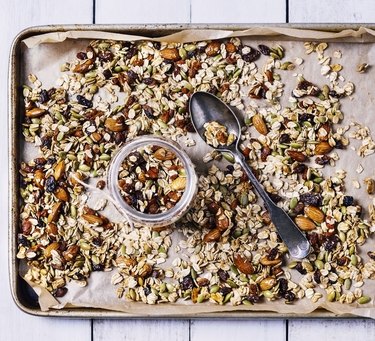
1. Muesli & Granola
If you want to enjoy the health benefits of oats but aren't thrilled with the texture of conventional oatmeal or overnight oats, there are still several ways to make oatmeal (and its slow-digesting carbs) part of a delicious breakfast. If you're more of a cold cereal person, for example, you'll find plenty of recipes online for homemade muesli and granola. These can incorporate most of the same tasty add-ins as oatmeal or overnight oats, so it's just a question of which texture you prefer.
2. Bars & Shakes
If you're more of a "grab and go" person than a "sit with a bowl" person, you can still have your oats in a number of ways. The most obvious examples are homemade protein bars and granola bars, which can be fine-tuned to suit your individual tastes or desired nutritional profile. Prefer to drink your breakfast? Include your oats in a protein shake. This is also a good way to use up overnight oats that have gotten softer than you'd like after a few days in the fridge.
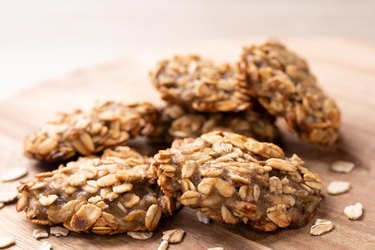
3. Baked Goods
Of course, you can always use oats while baking—in rolled-oat form or as oat flour. To make the latter at home, simply pulse rolled oats in a blender or food processor until they're powdery. Oatmeal brown bread, oatmeal scones or muffins, and (of course) oatmeal cookies can all be part of your repertoire.
4. Savory Oats
There's no reason your morning (or anytime) oats can't be savory too! A small mound of unsweetened cooked oatmeal can accompany your eggs and sausage in exactly the same way grits do in the South, for example. You can also treat oats like a bowl of congee (rice porridge), topping it with shredded leftover meats, dried or smoked fish, plenty of fresh herbs, ginger or bold-flavored condiments. If you use large (coarse) steel-cut oats or whole oat groats, you can even cook them risotto-style at dinnertime. Yum!
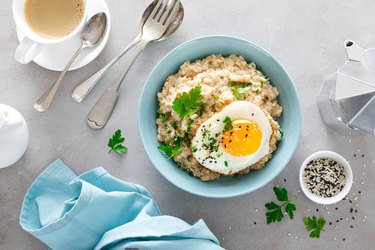
Regardless of which flavors and methods you prefer, we hope this oatmeal overview has opened your eyes to the versatile and totally delicious world of oats.